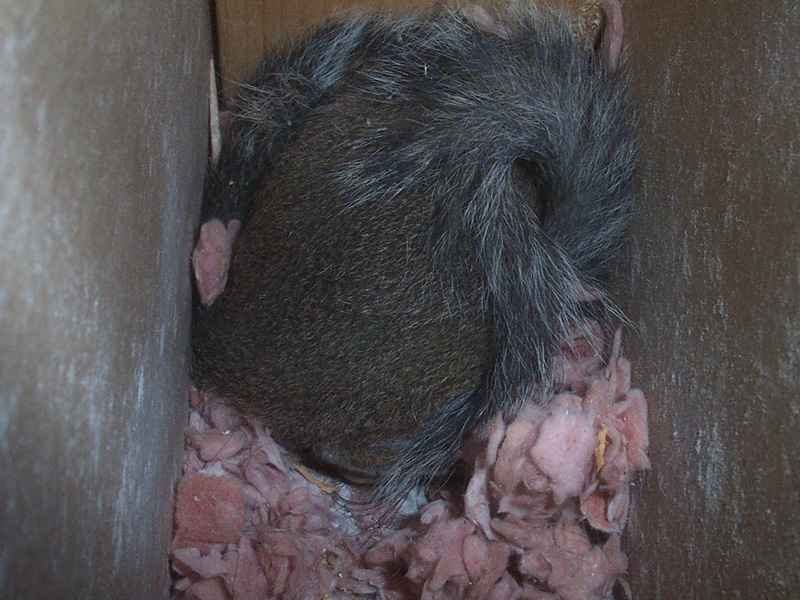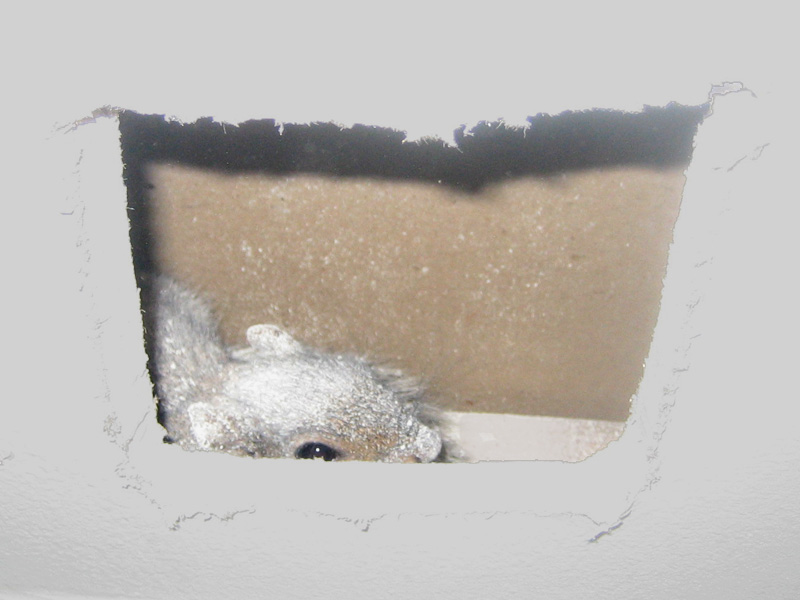- USA Wildlife Removal Education Guide and Resources
Squirrel in the Wall - What to Do

Removing A Squirrel Inside Your Walls - There are certain tell tale signs that will let you know that you have a squirrel living or moving through your walls, and knowing these will help you identify that the problem animal is a squirrel rather than any other animal. Few animals are as agile when they are climbing as squirrels, so if you do hear noises that move upwards or downwards, this will often be a sign that the problem animal is a squirrel. Rats and mice generally stay on the floor of a wall cavity, while other animals are likely to be scratching frantically, as they will have fallen into a cavity but will be struggling to get back out again.
Wall cavities are great for squirrels as their narrow nature means there is very little chance of any predator sneaking up on them, while the dark and warmth help to contribute for an environment that is very desirable as a den. The cavities provide the squirrel with a safe environment that will rarely smell of other animals, and these will often be chosen as a potential nesting place by the squirrel, as they will be looking for somewhere that any baby squirrels will be safe.
GET HELP: Do you need professional help with a squirrel problem? We have wildlife experts servicing almost every area of the USA! HIRE US IN YOUR TOWN
COSTS: You may want to read more about squirrels or the prices we charge for our services: READ ABOUT OUR SQUIRREL PRICES
The Difficulties Of Dealing With Squirrels In The Walls
Getting access to a wall cavity is often very challenging, as they will usually be sealed, with the only real option to get into the cavity being from above, and even if you can get to the cavity from the attic, the access will still be very limited. The other challenge is that if you have no access to cavity, it can be very difficult to see into the wall to identify if there are any squirrels left. This can mean cutting a hole in the drywall so that you can get a good look at what is happening, which will then come with a repair that isn't always cheap or easy.

Finding The Entry Points The Squirrel Is Using
Like a squirrel infestation in the attic, one of the most important steps you will need to take is to find out how the squirrel is getting in to the cavity, and this means examining the entire wall. Broken or damaged vents and holes around the top of the wall can be signs to look for, while it is also worth checking the attic to see if the squirrels are also present there and are accessing the cavity through the attic.
Trapping The Squirrel
This is one option to deal with a squirrel inside the walls, and there are live trapping options available, with repeater and cage traps often proving effective at catching the offending animal. This can either be mounted over an access hole if it is high on the wall, or left in a location where the squirrel will pass by it on a regular basis. There are also lethal trapping options, but dealing with a squirrel carcass isn't pleasant, and there is always the potential that the carcass will draw more animals to the area before you have the chance to dispose of it.
Excluding The Squirrel
This second option involves examining the wall thoroughly and finding all of the entry and exit points that the squirrel is using, and then sealing all but one of the holes that the animals are using. Once this is done you can install an exclusion funnel or netting over the remaining access hole, and the squirrel will then have to leave through that device, but will then find that they aren't able to get back in to attic as it is a one way exit.
Check For Baby Squirrels
This is one of the most important steps that you will need to take, as squirrels will usually look for nesting spots such as wall cavities if they are looking for a safe place to raise their babies. Most squirrels will have one breeding season where the litter is born in February or March, while older squirrels can breed twice a year and also give birth to a litter in June or July. It is important that you also remove the baby squirrels if they are present, otherwise they will die in the wall cavity, and the scent of the decaying carcasses can prove to be quite strong, and may draw other animals.
Sealing The Wall Cavity
Once you are sure that all of the squirrels in the cavity have been accounted for and they have either been removed, relocated or excluded, it is then time to make the permanent repairs that will prevent the problem from happening again. If the squirrels were coming in through damaged vents, make sure that they are repaired or replaced, while any holes in the masonry should be sealed with mortar to make sure that even the most dedicated squirrel won't be able to gnaw its way back in.
Go back to the main Squirrel Removal page for more information about what to do if you have squirrels in your walls. Do you hear scratching sounds in the walls? Is there a dead squirrel stuck in the wall cavity creating a smell or odor? Or maybe a nest of baby squirrel in the wall. Can they cause damage, and how do you get squirrel out of the wall?

